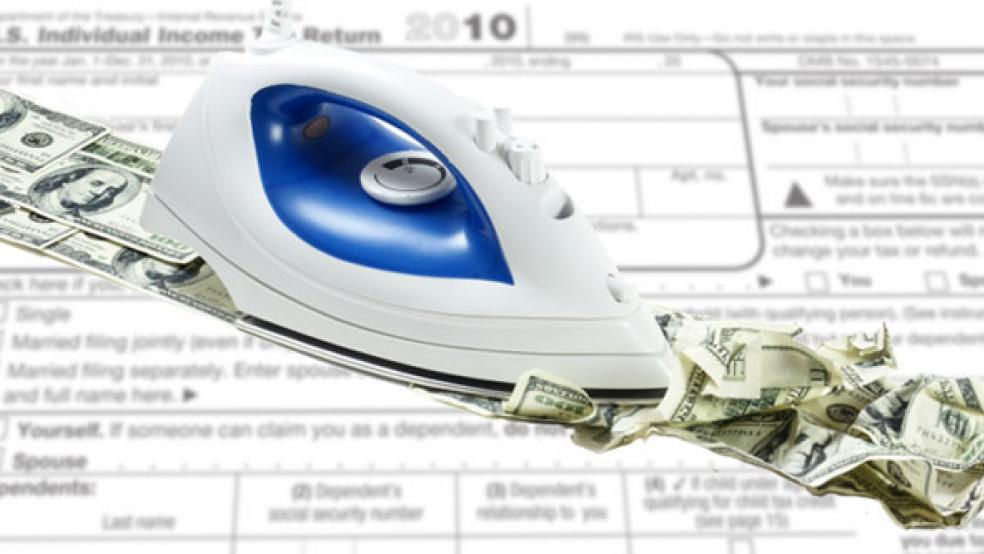It sounds like a safe political gambit: Implement a new flat tax plan to simplify the federal tax code and eliminate special interest write-offs and loopholes. If Americans didn’t like it, -- no problem -- they would have the option of sticking with the current system.
GOP presidential contenders Newt Gingrich and Rick Perry have both proposed this dual tax system, and both have been lauded for their efforts by long-time flat-tax enthusiast Steve Forbes and anti-tax crusader Grover Norquist. Perry's plan calls for a 20% flat tax rate on individuals and 20% corporate rate. Gingrich's calls for a 15% flat tax rate on individuals and a 12.5% corporate rate. The problem: Their plans could cost the government a bundle, raising the deficit even more.
Operating that type of dual tax system, which lays a flat tax option on top of the current code, is a sure recipe for revenue loss and added complications for both taxpayers and the Treasury and Internal Revenue Service, they say.
Twenty-five countries including Russia, Lithuania, Hong Kong, and Iceland have enacted flat tax systems for individuals, but only Hong Kong makes that option elective. But tax experts warn that this “one from column A or one from Column B” approach would be highly risky.
“It’s somewhere between ‘impossible’ and ‘no-freaking way’ could a system like this realistically function in the U.S.,” said Paul Caron, a tax law professor at the University of Cincinnati and publisher and editor of TaxProf, the most popular tax blog on the internet.
One of the original flat tax advocates, Former Republican House Majority Leader Dick Armey of Texas, says that while a flat tax is “the single greatest instrument available to inspire growth in the American economy,” it’s not worth enacting if the current federal tax code remains, as Gingrich and Perry are suggesting.
“It takes a lot more boldness then this,” Armey told The Fiscal Times, calling these plans “cockamamie hybrids.”
“Now you’ve got to hire extra accountants who have to spend extra time figuring the tax code both ways, the old way and the flat tax way.”
“The right way to do the flat tax is to do it straightforward and completely, with no exceptions, and as a substitution for the current tax code,” said Armey, a former college economics professor. “If you double track it like that, you leave all the loopholes, and you don’t get to eliminate those big compliance costs since now you’ve got to hire extra accountants who have to spend extra time figuring the tax code both ways, the old way and the flat tax way….It’s counterproductive to good economics.”
Interest in a flat tax – a simplified system in which one or two tax rates are applied to gross income but sans most tax deductions and credits --has suddenly come back into vogue thanks to Gingrich, the former House speaker, Perry, the governor of Texas, and former Godfather’s Pizza CEO Herman Cain before he dropped out over a sexual harassment controversy.
Steve Forbes, chair of Forbes Media who ran for president on a flat tax platform in 1996, is excited by the dual approach taken by Perry and Gingrich. But the only justification for keeping the current system is to help Americans overcome their fears “that the new one will somehow hurt them because they might lose this or they might lose that,” Forbes told The Fiscal Times. “This way, you have a safety valve. So it just lowers the political temperature and lowers the political barrier to enacting the thing. That’s all it’s meant to do.”
Under both plans, those opting for the flat tax would not be taxed on capital gains, dividends, interest, or Social Security, and would still be able to claim deductions for charitable contributions and mortgage interest. Both plans would do away with the estate tax, the Alternative Minimum Tax, and cut the corporate rate—Perry’s to 20 percent and Gingrich’s to 12.5 percent.
Neither plan would benefit all income classes equally. Since 47 percent of all Americans pay no federal income tax because of low income, they would be hit hardest if they opted for a flat tax. Electing a flat tax would be a no-brainer for most affluent taxpayers, since all the flat tax proposals would set dramatically lower rates than the current 35 percent. It would also eliminate the current 15 percent tax on capital gains from sales of stocks, bonds, and real estate. Over the past twenty years, about half of all capital gains have gone to the wealthiest 0.1 percent of taxpayers – think Warren Buffet -- and more than 80 percent has gone to the top 5 percent of earners. Yet, with over 60 percent of American households invested in 401(k) programs, most working Americans would benefit from elimination of capital gains.
Similarly, most taxpayers in the 10 or 15 percent income tax brackets will be inclined to remain in the current tax system since the flat tax rate would likely be higher than what they currently pay and would mean forsaking deductions and credits. “So if you’re not longer going to tax Bill Gates on the amount he takes in and doesn’t spend, and the lower income folks will stay as is, where’s that tax going to come from? Inevitably, the middle class will end up picking up the tab,” said H. David Rosenbloom, director of the International Tax Program at New York University School of Law.
“Their solution simply is to not raise enough revenue to support the government, meaning deficits would just mount and mount.”
Forbes disputes the notion that the middle class will end up paying for a system that will overwhelm the IRS. Neither the Gingrich nor Perry plans increase taxes on any income group, so there’s no reason to think the middle class would be hit, he said. “You pick certain people who might get more of a cut than others, but no one’s tax burden rises,” he said.
According to estimates compiled by the Tax Policy Center, the Perry and Gingrich plans would cost the Treasury $570 billion and $850 billion, respectively, in revenue over one year---more than one-fifth and one-third of the $2.3 trillion in revenue the federal government will collect in 2011. “Their solution simply is to not raise enough revenue to support the government, meaning deficits would just mount and mount,” said Ed Kleinbard, a tax law professor at the University of Southern California and a former chief of staff for the congressional Joint Committee on Taxation. “That kind of talk may be what the [conservative political] base likes to hear at this point in the election cycle , but this is not something the right or the left could base policy on soundly….These are tax leprechauns and unicorns in terms of the extent to which the proposals are grounded in reality.”
This kind of dual-track tax system is virtually guaranteed to produce less revenue, said Stephen Shay, a tax law professor at Harvard Law School. Giving people the choice between taking a flat tax or keeping their rates and deductions will naturally lead most middle class taxpayers to run the numbers and choose the option that lowers their tax bill the most. For that reason, “any election in relation to the current system is a revenue loser assuming rational human response,” Shay said
Hank Gutman, a principal with KPMG LLP’s Washington National Tax practice, disagrees with Forbes. “By definition, these plans will hit middle income earners who earn most of their income from wages, because that’s the only thing left in the tax base,” Gutman said. In short, somebody will have to pay more if the Perry and Gingrich scenarios drain the Treasury of hundreds of billions of dollars in revenues, as these experts are predicting.
It’s ironic that Gingrich and Perry are advertising their proposals as ways to simplify life for both the taxpayer and the government when it would almost certainly greatly complicate people’s lives, Rosenbloom and Gutman said. Perry likes to hold up a postcard to show how simple it would be to file a tax return under his system.
“However you look at it, two tax systems operating side-by-side like this have got to be more complicated than one, even if some people at the top of the income spectrum are able to file their taxes on a postcard,” Rosenbloom said. The Internal Revenue Service , which is itself contending with budget cuts, would need to devise a new administrative structure to handle another tax plan with new bases, which would require new forms and computer programs, Gutman said. “It just adds another layer of complexity. How can this be good?”





